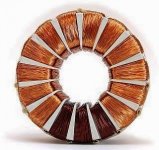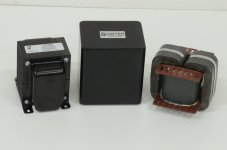See this is the thing; many builders make choices to suit their flawed speaker system and make pronouncements based upon an idiosyncratic sounding speaker. Most of these belong to the single driver crowd.
Perhaps the better transformer will sound the worse because it does not mitigate any flaws downstream. Surely worth pondering.
Best, Kris
I'm sure there's some truth in this. The virtue of single units, apart from easy construction, is the very immediate sound. Nothing added in the crossover. I'm all for minimum parts count in the active circuit, which is why I use a 2 stage all-DHT setup in filament bias with no cathode bypass caps. It's a very minimalistic system, though the power and filament supplies are pretty complex. But in audio, simple has downsides - you're asking components to do a lot. And in this case, you're asking a single speaker unit to have smooth and flat treble while still giving you the desired midrange and most of the bass you need. I must say the Alpair 10 pulls it off with the LL1664 OPT. And the gain in immediacy is certainly worth it. One way to go. The immediacy is rather addictive - it's very dynamic and detailed and not at all flat sounding.
But there's a basic paradox here I'm just not understanding. Surely the standard core and the amorphous core OPTs have pretty similar - i.e. flat - frequency responses? So where is the added treble energy coming from? The "harshness" or "extra detail" or whatever you call it? There's no listener fatigue with the LL1664 but there is with the amorphous core. So where is the listener fatigue coming from? Is it or isn't it a question of frequency response? If it is, where's the difference? If it isn't, then what is it?
Having thought about this, I think there may have been some oscillation in my system.
I've made some mods and listening to the amorphous OPT again. I may well stick with it now. One thing I found is that I can listen at lower volumes because it is certainly very clear. So that contributes to less listener fatigue.
I've made some mods and listening to the amorphous OPT again. I may well stick with it now. One thing I found is that I can listen at lower volumes because it is certainly very clear. So that contributes to less listener fatigue.
In the case of a reputable manufacturer like James I think tht would be a fair assumption.
Magnequest are very conservative in their specification. From memory their FS-030 is rated at 65mA, yet is capable of passing significantly more current without saturation and deterioration of bass performance.
Magneqest fs030 should be set to 60ma mode, sound quality is very slow low very good
I use these OPT's for 300B (and GU-50 with adapter), Noguchi using Hitachi finemet core: http://noguchi-trans.co.jp/digitalcatalog/main/fm24ws3k.pdf
Expensive, but worth it.
In my DAC and tube pre (and the driver stage of 300B in the amplifier) I have both transformer coupled (Noguchi finemet) and capacitor coupled (KBG-MN and Duelund Cast Cu) outputs. Capacitor coupled outputs use the primary of the output transformer as an anode choke for better sound than resistor loaded anode. This is a clever way to have both types of coupling, transformer coupling for the best, most musical sound and better impedance matching and anode choke loaded capacitor coupled output for higher gain (also good sound!) when needed with different tube combinations. If one is thinking to go anode choke + cap out route, then buy a transformer to get both options to see which suit's ones taste better. Use a switch to decouple the output cap completely when the transformer coupling is used so it does not influence anything.
Expensive, but worth it.
In my DAC and tube pre (and the driver stage of 300B in the amplifier) I have both transformer coupled (Noguchi finemet) and capacitor coupled (KBG-MN and Duelund Cast Cu) outputs. Capacitor coupled outputs use the primary of the output transformer as an anode choke for better sound than resistor loaded anode. This is a clever way to have both types of coupling, transformer coupling for the best, most musical sound and better impedance matching and anode choke loaded capacitor coupled output for higher gain (also good sound!) when needed with different tube combinations. If one is thinking to go anode choke + cap out route, then buy a transformer to get both options to see which suit's ones taste better. Use a switch to decouple the output cap completely when the transformer coupling is used so it does not influence anything.
Last edited:
I've made some mods and listening to the amorphous OPT again. I may well stick with it now. One thing I found is that I can listen at lower volumes because it is certainly very clear. So that contributes to less listener fatigue.
Since I wrote this the amorphous OPT has become a fixture in my system, and I do think it mellows with burning in. I don't normally bother thinking about burn-in but there may be a case for it here.
Otherwise I've been working on a few amplifiers over the summer break. Today I compared four OPTs, all around 3K SE
1. O'Netics Level One - rich full sound, with mellow and sweet treble. Very easy to listen to.
2. O'Netics smaller OPT he made for George Wright a while ago - smaller size OPT and a slightly lighter sound. All the usual O'Netics sweetness and mellow sound, but a trifle lighter in presentation which is agreeable to me.
3. LL1664 - different sound than O'Netics, clearer but not so sweet. At first I preferred this but lately I've come to like the smaller O'Netics in particular.
4. LL1620 - this is a big beast with multiple taps and three choices of primary impedance. I think it suffers from this and doesn't sound as clear as the smaller LL1664. It sounded better at 5K than 3K with my usual PSE 4P1L output stage.
All the above will give you good sound, though I think the LL1620 would not be a choice unless you needed the versatility it offers.
So - anything new or worth a comment in the world of SE OPTs?
I have a friend who use 3k2 Toroidy front Poland he is very happy. Sound and measures are very good the bass is very fast and good detail.
Who has experience with this company Toroidy?
Who has experience with this company Toroidy?
i bought el84se from tme.eu
did quick listen, no problems.
price is low, you should try yourself
did quick listen, no problems.
price is low, you should try yourself
Where did you see the OPTs?
Some useful mains transformers for tubes like this:
SU78B-230230 NORATEL - Transformer: mains | TME - Electronic components
Some useful mains transformers for tubes like this:
SU78B-230230 NORATEL - Transformer: mains | TME - Electronic components
pl802 what primary ?Thanks Merlin....I use that in my GU-50 amp.
Great sound to be had with Goodmans Axiom80 and Axiom 301.
At full power the opt toroidal keep quiet ?
very interesting
I have a Monoliith on my GM70 and Intact Audio on the 300b amp.
I have tried many transformers on both amps, I prefer the Intact Audio on 300b amp and monolith on GM70
They are silky smooth compared to commodity grade transformers
I have tried many transformers on both amps, I prefer the Intact Audio on 300b amp and monolith on GM70
They are silky smooth compared to commodity grade transformers
I have a Monoliith on my GM70 and Intact Audio on the 300b amp.
I have tried many transformers on both amps, I prefer the Intact Audio on 300b amp and monolith on GM70
They are silky smooth compared to commodity grade transformers
Those are two truly high end OPTS. Did you try the transformers the other way round at all so you could compare them directly? These aren't amorphous core? Have you tried amorphous core in comparison?
Hi
in this thread:
why not E88C
post 60 there are some tests on three different OT s.e.
In Trafo2.jpg there is a photo of them.
In my opinion, with 2.5 k ohm /8 ohm sec. we need 20H, real. So we can get the good results on low end maybe with a little loss on high freq, but this is not a grat problem
Walter
in this thread:
why not E88C
post 60 there are some tests on three different OT s.e.
In Trafo2.jpg there is a photo of them.
In my opinion, with 2.5 k ohm /8 ohm sec. we need 20H, real. So we can get the good results on low end maybe with a little loss on high freq, but this is not a grat problem
Walter
Attachments
Hi. Has anyone used the new Hammond SEA OPTs? My understanding is that there were changes made from the SE to SEA transformers. I'm considering the 1627SEA or the 1630SEA for a new build but I don't see much comment on them. They are relatively affordable and I can pick them up locally without shipping, exchange and duties required when ordering out of country. No point though if they are no good. Any input would be appreciated.
Look at hammond site and you can understand the differences.
Hammond Mfg. - "Classic" Single Ended Tube Output Transformers - (1627 - 1642 Series)
The SEA have the UL tap. Not the type 1642SE & 1638SEA
For 300B tha 1627SE is a good choice; look at the performance I sent.
The L is not high, around 9 H instead of 20 H declared so the performance in low end aren't so fine mainly in THD vs frequency test
Walter
Hammond Mfg. - "Classic" Single Ended Tube Output Transformers - (1627 - 1642 Series)
The SEA have the UL tap. Not the type 1642SE & 1638SEA
For 300B tha 1627SE is a good choice; look at the performance I sent.
The L is not high, around 9 H instead of 20 H declared so the performance in low end aren't so fine mainly in THD vs frequency test
Walter
Last edited:
The L is not high, around 9 H instead of 20 H declared so the performance in low end aren't so fine mainly in THD vs frequency test
Do you have a link to whoever tested these? I like to keep notes around for when customers want me to build something with Hammond OPTs.
problem with L testing is the fact that magnetization current has big effect.
so, if you are measing with typical multimeter, you get low value.
you should wire primary to autotransformer ~50Hz and adjust to near max U~ ( and measure I~ going thru primary)
50H @ 50Hz = 15k7 = 12.73mA@200V~
so, if you are measing with typical multimeter, you get low value.
you should wire primary to autotransformer ~50Hz and adjust to near max U~ ( and measure I~ going thru primary)
50H @ 50Hz = 15k7 = 12.73mA@200V~
- Home
- Amplifiers
- Tubes / Valves
- Best 300B SE OPT?

